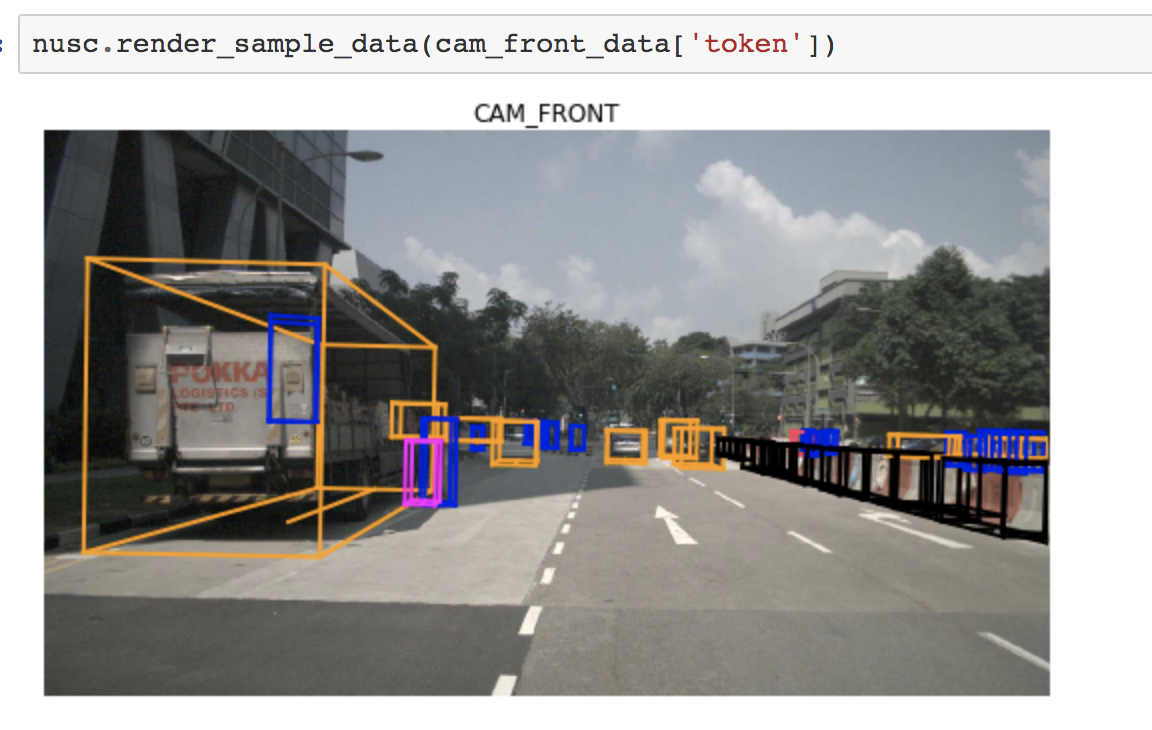nuScenes数据集使用
官方提供的开发者工具:
nuscenes-devkit
1 | pip install nuscenes-devkit |
使用
或者修改源码/Users/wennie/anaconda3/lib/python3.6/site-packages/nuscenes,以使用自己的文件结构。
1 2 3 4 5 | /data/sets/nuscenes samples - Sensor data for keyframes. sweeps - Sensor data for intermediate frames. maps - Folder for all map files: rasterized .png images and vectorized .json files. v1.0-* - JSON tables that include all the meta data and annotations. Each split (trainval, test, mini) is provided in a separate folder. |
部分功能:
主要参考官方的应用示例
一、 结合各表,获取信息
1 2 3 | # 参数1:各个表名 # 参数2:token nusc.get('sample', first_sample_token) |
举例:sample
data中根据各传感器token,可以得到传感器文件的存放位置。
anns表示该sample中存在的所有Ground Truth,其token可以得到物体的标注信息。

举例:sample_data

举例:sample_annotation

拓展:读取image_annotations
image_annotations 文件获得方法:
跑一下/nuscenes/scripts/export_2d_annotations_as_json.py,即可获得。
源码接口不支持使用

二、 各坐标系间的转换
(1)转换Ground Truth坐标,使其与像素坐标系一致
- 转换为像素坐标系下的二维坐标,即image_annotations.json里的值
- 转换为像素坐标系下的三维坐标:
render_sample_data 函数中有具体实现步骤。

(2)转换Ground Truth坐标,使其与雷达坐标系一致
- 得到一个三维的box坐标
1 2 3 | # Returns the data path as well as all annotations related to that sample_data. # Note that the boxes are transformed into the current sensor's coordinate frame. _, boxes, _ = nusc.get_sample_data(sensor_token) |
- 都映射到二维后,查看Ground Truth(即图中的框)与点云:


(3)转换点云坐标,使其与像素坐标系一致
- 得到坐标
已经筛去超出图像大小1600*900的点。
1 2 3 4 5 | # 需使用NuScenesExplorer类方法 from nuscenes.nuscenes import NuScenesExplorer nusc_exp = NuScenesExplorer(nusc) nusc_exp.map_pointcloud_to_image(my_sample['data']['RADAR_FRONT'],my_sample['data']['CAM_FRONT']) |
- 查看图像

三、毫米波雷达点云数据
源码在nuscenes/utils/data_classes.py
1 2 3 4 5 | point_sensor = nusc.get('sample_data', sensor_token) pcl_path = osp.join(DATAROOT, point_sensor['filename']) pc = RadarPointCloud.from_file(pcl_path) pc.points |
内容:
1 2 3 4 5 6 7 8 | # FIELDS x y z dyn_prop id rcs vx vy vx_comp vy_comp is_quality_valid ambig_state x_rms y_rms invalid_state pdh0 vx_rms vy_rms # Below some of the fields are explained in more detail: # x is front, y is left # vx, vy are the velocities in m/s. # vx_comp, vy_comp are the velocities in m/s compensated by the ego motion. # We recommend using the compensated velocities. |


